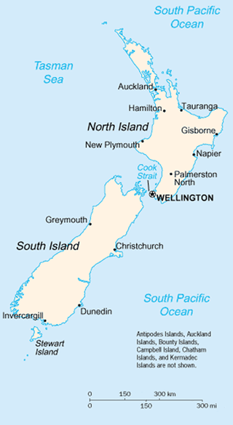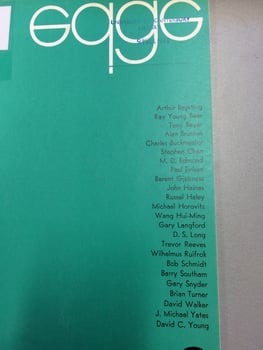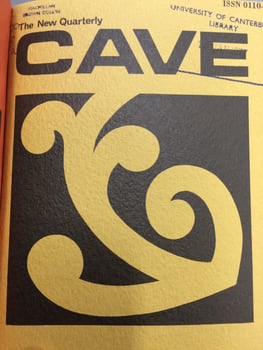What kinds of literary journals have been most popular in New Zealand in the twentieth and twenty-first centuries? This isn’t a question that most American readers have an answer to, given that many New Zealand literary journals simply are not readily available in the United States (or on the internet, for that matter). Yet New Zealand journals like Cave, Edge, and Landfall have been publishing scholarship, fiction, and poetry for decades, featuring works by famous New Zealand authors as well as award-winning poets and writers from other parts of the world. If you’re interested in learning more about these New Zealand journals, allow us to provide you with an introduction!
Landfall and Literary Scholarship in New Zealand
 The longest-running journal in New Zealand, and perhaps the best known, is Landfall. The journal began in the 1940s, featuring imaginative literature, reviews, art, and scholarship. The early issues primarily featured works by New Zealand writers and others associated with the Commonwealth, particularly in the immediate postwar years. In those early years, the literary analysis contained within the journal fell within a small section described as “Commentaries,” which occasionally presented printed correspondence between and among writers.
The longest-running journal in New Zealand, and perhaps the best known, is Landfall. The journal began in the 1940s, featuring imaginative literature, reviews, art, and scholarship. The early issues primarily featured works by New Zealand writers and others associated with the Commonwealth, particularly in the immediate postwar years. In those early years, the literary analysis contained within the journal fell within a small section described as “Commentaries,” which occasionally presented printed correspondence between and among writers.
Over the years, in addition to featuring works of fiction and poetry by postmodern New Zealand writers such as Keri Hulme in the 1980s, the journal also began featuring scholarship by prominent New Zealand academics, such as Simon During. In more than seven decades, Landfall has become more global in scope while also expanding its local reach, featuring new and exciting Maori writers from New Zealand.
Fiction, Poetry, and Other Imaginative Works in Edge
 If you were a subscriber to Edge, a journal published in Wellington, New Zealand, in the early 1970s, what might you have expected to find inside? First, you should know that the first volume of the journal appeared in 1971, featuring works by writers from various parts of the world. For instance, several of Jorge Luis Borges’s short stories and fragmentary writings appeared in the August 1971 issue, including “Invocation to Joyce” and “In Praise of Darkness.” The issue also featured poems by Charles Simic, including “Brooms” and “The Soup.” Readers would also have gotten access to W.S. Merwin’s “Eskimo poem from a French version by Paul Mercier,” as well as “Crow poem adapted from Robert Lowie’s Crow Texts.”
If you were a subscriber to Edge, a journal published in Wellington, New Zealand, in the early 1970s, what might you have expected to find inside? First, you should know that the first volume of the journal appeared in 1971, featuring works by writers from various parts of the world. For instance, several of Jorge Luis Borges’s short stories and fragmentary writings appeared in the August 1971 issue, including “Invocation to Joyce” and “In Praise of Darkness.” The issue also featured poems by Charles Simic, including “Brooms” and “The Soup.” Readers would also have gotten access to W.S. Merwin’s “Eskimo poem from a French version by Paul Mercier,” as well as “Crow poem adapted from Robert Lowie’s Crow Texts.”
Let’s move onto the February 1972 issue. The first poem inside the journal is Gary Snyder’s “The Bath.” Snyder became known initially as a writer of the Beat Generation and often is considered one of the poets of the San Francisco Renaissance along with names like Jack Spicer and Robert Duncan. But Snyder isn’t the only American poet presented in this issue of Edge. We were thrilled to see the work of the Meskwaki poet, Ray Young Bear, just four lines below Snyder’s name. In this particular issue of the journal, Ray Young Bear’s poem “Coming Back Home” was featured prominently. In addition to poetry, the journal also featured artwork, such as two woodcuts of the Chinese-born American immigrant artist Hui-Ming Wang.
By August of 1972, Edge began featuring the poems of Tomas Tranströmer on a regular basis, with English translations of “Night Duty” and “Traffic.”
Emergence of “The New Quarterly CAVE: An International Review of Arts and Ideas”
 In 1976, a new literary journal emerged on the scene. According to the Preface from the first issue, the editors of CAVE described it as “a New Zealand based journal, seeking to promote the cause of New Zealand literature and culture in a wide sense, and according to the highest standards.” Yet over its years of publication, the journal became a space for the publication of world literature in the South Pacific. As such, the subtitle of the journal came to reflect its global focus.
In 1976, a new literary journal emerged on the scene. According to the Preface from the first issue, the editors of CAVE described it as “a New Zealand based journal, seeking to promote the cause of New Zealand literature and culture in a wide sense, and according to the highest standards.” Yet over its years of publication, the journal became a space for the publication of world literature in the South Pacific. As such, the subtitle of the journal came to reflect its global focus.
In the early years of publication, CAVE featured writings by European New Zealand writers and Maori authors such as Van Phillips, as well as internationally acclaimed short-story writers and poets such as Horacio Quiroga. The journal also featured English-language translations of Turkish and Guatemalan poetry. In subsequent issues, CAVE began an entire section for book reviews spanning contemporary world literature.
While these journals aren’t especially easy to come by if you’re looking to add to your collection, some targeted book shopping—especially if you’re traveling to Australia or New Zealand—might lead to you owning some original copies of Landfall, Edge, and CAVE. If you happen to stumble upon a treasure trove of New Zealand literary magazines and don’t plan to add them all to your collection, share the wealth and let us know!









